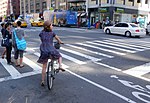Saks Fifth Avenue flagship store

The Saks Fifth Avenue flagship store is a department store in Midtown Manhattan, New York City, within the luxury shopping district on Fifth Avenue between 49th and 50th Streets. The original 10-story structure at 611 Fifth Avenue has served as the flagship store of Saks Fifth Avenue since its completion in 1924. The store also occupies part of 623 Fifth Avenue, a 36-story tower completed in 1990. The original Saks Fifth Avenue Building was designed by Starrett & van Vleck in the classical style. It contains a facade made of Indiana limestone, brick, and cast-stone, with chamfered corners on Fifth Avenue at 49th and 50th Streets. Saks Fifth Avenue was the first department store on Fifth Avenue to comply with the 1916 Zoning Resolution, with setbacks on its upper floors. The tower addition at 623 Fifth Avenue was designed by Lee Harris Pomeroy Associates and Abramovitz Kingsland Schiff. The tower is partially designed in the style of the original structure. The Saks Fifth Avenue Building was planned in the early 20th century by Horace Saks, head of Saks & Company, which had a flagship store at Herald Square. The building was constructed from 1922 to 1924 as "Saks-Fifth Avenue", a joint venture between Saks and his cousin Bernard Gimbel. Saks Fifth Avenue later became a department store chain in its own right, and the Fifth Avenue store became a flagship location. The original building was designated a New York City Landmark in 1984 to allow the development of the 623 Fifth Avenue tower annex. Over the years, the store has undergone numerous modifications.
Excerpt from the Wikipedia article Saks Fifth Avenue flagship store (License: CC BY-SA 3.0, Authors, Images).Saks Fifth Avenue flagship store
5th Avenue, New York Manhattan
Geographical coordinates (GPS) Address Website External links Nearby Places Show on map
Geographical coordinates (GPS)
| Latitude | Longitude |
|---|---|
| N 40.758055555556 ° | E -73.976944444444 ° |
Address
Saks Fifth Avenue
5th Avenue 611
10035 New York, Manhattan
New York, United States
Open on Google Maps








